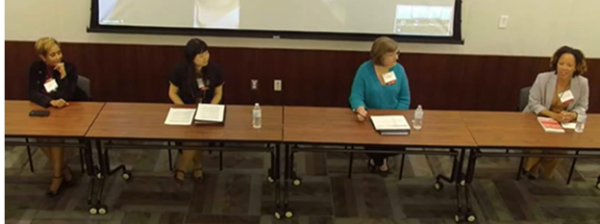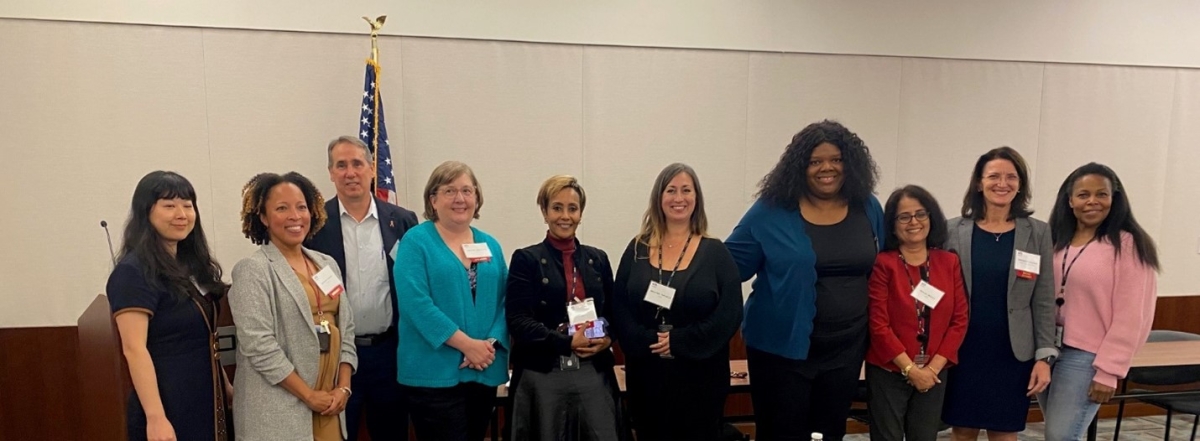Combining Forces with the VDOT NOVA District for "VDOT Tech Fluency - Adapt, Innovate, Evolve"
By Cerasela Cristei, WTS-DC
October 2022
On October 18, the WTS-DC chapter hosted its eighth annual event with the NOVA District of Virginia Department of Transportation. More than 50 people attended the event in person, and 15 people attended virtually. Catherine McGhee, VDOT Chief Deputy Commissioner, was the keynote speaker for the event. Joining Ms. McGhee were panelists Denise Cantwell, P.E. (VDOT NOVA District - District Construction Engineer), Houda Ali, P.M.P. (VDOT NOVA District - Assistant Director, Transportation and Land Use for Fairfax & Arlington Counties), Angel Tao, P.E. (VDOT's NOVA District - Prince William Preliminary Engineering Manager), and Candice Gibson, P.E. (Engineer for VDOT's Office of Strategic Innovation).

The keynote speaker, Cathy McGhee, carries a wealth of industry knowledge that will continue to place VDOT as a leader in transportation innovation and technology. She has more than 30 years of experience in traffic engineering and system operations, intelligent transportation systems, and data and performance measurement. Cathy received her bachelor’s degree from California Polytechnic State University, San Luis Obispo, and her master’s degree from the University of Virginia, both in civil engineering. She has held a professional engineer’s license in Virginia since 2004. After two years of work as an engineer, Cathy decided to make a change. After finishing graduate school, she received an assistantship at Virginia Transportation Research Council and there, she found her home.
Currently, Cathy is working on developing a new structure for VDOT, combining the divisions of traffic engineering and traffic operations into one division: traffic operations. This division will help the Department prepare for what the future will bring with respect to connected and automated vehicles. The Integrated Corridor Management Technology will introduce better ways to manage the current and future system demands.
At the event, Cathy spoke about the electric grid and the goal of installing electric vehicle charging stations at every 50 miles on the alternative fuel corridors (the interstates). Each charging station will have four ports at 150 KW each – high-speed charging stations. When this goal will be accomplished the program will expand beyond the interstates, into communities. Cathy believes that innovation is going to continue to be really important in delivering a transportation system that meets the needs of everyone over the next few decades.
In addition to VDOT's Deputy Chief Commissioner and the panelists, VDOT Northern VA District's District Engineer, John Lynch, his Deputy District Engineer, Bill Cuttler, as well as his Deputy District Administrator, Monica Bhatia, attended the event. We are thankful for their support of WTS-DC events.
The panelists addressed many interesting topics, including:
What are some of VDOT’s most interesting technological accomplishments that happened during the past few years?
- Flashing yellow arrows at high-risk intersections – low cost and high impact by reducing the number of crashes at intersections.
- Virtual meetings.
- Incorporating technology into everyday activities including construction inspections.
- Accepting electronic submissions and signatures.
- Using crowdsourcing for idea management.
- Progressive Design-Build – the first implementation in NOVA – the I-95 and Route 123 interchange improvements project.
What is the latest news from the Office of Strategic Innovation? What is your favorite transportation research topic/pilot project?
- There is collaboration spanning the entire NOVA District when it comes to innovation in different program areas. For example, ideaDRIVER provides a collaborative space for agency staff to share innovative ideas and develop innovative solutions to complex problems. This idea management tool allows VDOT to leverage the collective knowledge and creativity of its workforce and to cultivate a growing stream of ideas for better ways to solve problems. Some of the ideas implemented have provided more efficient operations during snow emergencies.
- A favorite transportation topic/project is the connected vehicles ecosystem. This is how VDOT will prepare itself and Virginia’s roadways for the deployment of a connected and automated vehicle (CAV) ecosystem. VDOT is building strong relationships with the municipalities and the large business owners to gain support in promoting and implementing the program.
- VDOT has championed innovation through the VDOT Voices Webinar Series, where each district shares success stories of implementations in their respective district. VDOT held several district innovation labs where teams work on solutions to challenges, winning ideas are piloted, and solutions are scaled across the district and across the agency statewide.
- Innovation ToolShed is an online resource consolidating VDOT’s wide array of innovation tools and resources into a one-stop shop as a convenience for all VDOT employees.
- The Regional Multimodal Mobility Program (RM3P) program leverages the collaborative use of real-time data to improve travel safety, reliability, and mobility.
- Artificial Intelligence based Decision Support System (AI DSS) will be a tool for the transportation operators to ensure a coordinated multi-modal and multi-agency response related to weather events and/or congestion events. This program will be able to predict the disruptions to the transportation network and what the impacts of those disruptions are expected to be.
- VDOT has a Commuter Parking Information System that will include a real-time, app-based parking availability information system, providing reliable information about parking space availability at lots serving bus, vanpool, and carpool commuters.
- Dynamic Incentivization will be a data-driven system offering the public incentives to modify their travel choices and behaviors in response to real-time travel conditions. The incentives will be offered by regional agencies and third-party providers.
- Dynamic management of the demand is aptly labeled the fourth renewable energy. VDOT is also looking at renewable energy (solar/wind) to decrease VDOT’s impact on climate change while also increasing resiliency, cost savings and sustainability.

Do you have a suggestion for a good book in leadership? What are some of the key lessons you learned from that book?
- Fail More: Embrace, Learn, and Adapt to Failure as a Way to Success by Bill Wooditch
- How Women Rise: Break the 12 Habits Holding You Back from Your Next Raise, Promotion or Job by Sally Helgesen and Marshall Goldsmith
- Emotional Intelligence: Why It Can Matter More Than IQ by Daniel Goleman
- Crucial Conversations Tools for Talking When Stakes Are High, by Kerry Patterson, Joseph Grenny, and Ron McMillan
In a few sentences, what advice would you have for women who want to move into leadership positions in transportation and/or advance their careers.
- Don't fire your career goals early on and fall in love with your job. Set the road map with whatever you need to get there and never forget to advocate for yourself.
- Keep learning; never stop.
- One does not need to be great at math and be great all the time to be a successful professional.
- Have a mindset that you belong; transportation is for you; take up space in the room and help others take up space in the room.

WTS-DC thanks the NOVA District for its continued collaboration on this annual event and our keynote speaker, Cathy McGhee, and all our panelists!